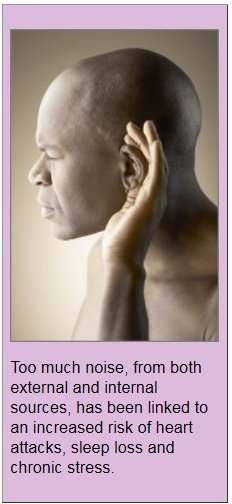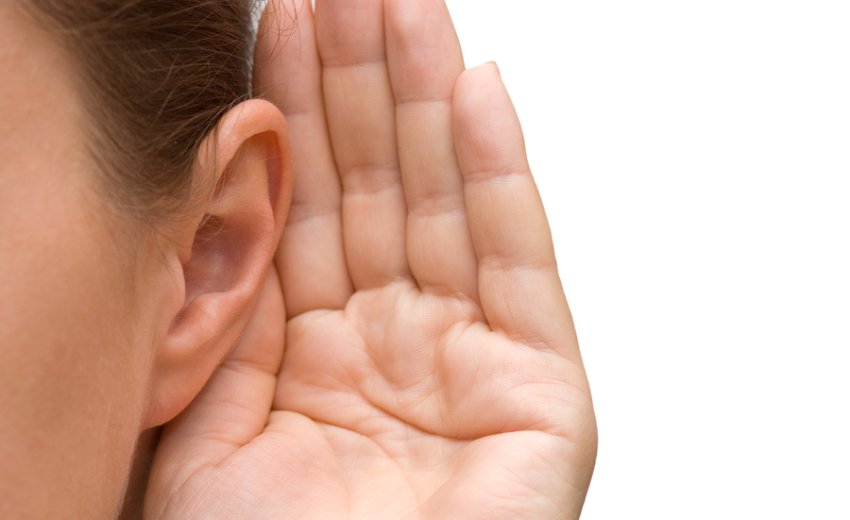The Healing Power of "Silence"
©2015 Health Realizations, Inc. Update
Noise exists all around us, externally in the form of things like traffic, television, and cell phones, and internally in the form of constant thoughts. More and more, both mainstream and alternative experts are encouraging increased silence, both from outside and inside your mind, as a way to improve your health and well-being.
 Hospitals Reduce Noise to Help Healing
Hospitals Reduce Noise to Help Healing
Noise levels at hospitals around the world are known to be incredibly high, and now anti-noise campaigns have been started to help keep things quiet.
According to Margaret Amato, clinical director of nursing at Montefiore Medical Center, noise levels during a shift change in a hospital can reach 113 decibels (a motorcycle, for comparison, is 95 decibels).
"Hospital noise levels are far too high internationally, and this has been known for decades," said Roger Ulrich, a professor of architecture at Texas A&M University.
Such noisiness causes patients to lose sleep, have higher blood pressure and may make them more likely to be readmitted, he says.
According to a study by Ulrich, heart patients who stayed in hospital rooms with sound-absorbing ceiling tiles were less likely to be readmitted within 30 to 60 days than patients in rooms with typical sound-reflecting tiles.
"The cost of readmission for a cardiac patient is very high," Ulrich said. "Preventing one or two readmissions would save so much money that that alone would pay for the cost of upgrading the acoustic ceilings throughout the cardiology floor."
Loud Noise Increases the Risk of Heart Attack
Even outside of a hospital setting loud noises can harm your health. A study published in the European Heart Journal found that long-term exposure to high levels of noise increases the risk of a heart attack. Specifically:
-
Men who were exposed for a prolonged length of time had a 50 percent higher risk of heart attack than those not exposed.
-
Women who had been exposed to noise had a three times higher risk.
"We feel that, if you have a higher and longer exposure to noise, either environmental or workplace noise, you are at a higher risk for a heart attack," said lead investigator Dr. Stefan Willich.
To reduce external noise in your environment, turn down the TV (or turn it off entirely), consider using noise-reducing headphones, use heavy curtains and carpeting to drown outside noise, buy quieter appliances for your home and wear earplugs in extremely noisy situations you can't avoid.
Internal Noise Affects Your Health Too
Aside from external noise, the noise inside of your head can also greatly impact your health. As most of us know, recurring thoughts of anxiety, worry, anger or fear are not only incredibly draining, but they contribute to the stress in our lives.
In this never-ending cycle of internal noise, negative thoughts that are left unchecked can lead to chronic stress, and chronic stress has been linked to fatigue, back pain, stomach upset and headaches, along with numerous more serious illnesses, including heart disease, cancer, depression and more.
 Quieting Your Mind With Meditation
Quieting Your Mind With Meditation
One way to silence negative thoughts is through meditation, a practice that's gaining much popularity in the United States. Meditation helps you get in touch with the quieter levels of your mind, relaxes your body and lowers levels of stress hormones.
Many scientific studies have confirmed meditation's beneficial effects, which include:
-
Boosting the immune system
-
Lowering the risk of cancer and heart disease
- Lowering blood pressure
-
Improving concentration and sleep
-
Relieving headaches
-
Faster recovery after surgery
While you may be thinking that you simply don't have time to meditate, once you start you'll find it helps increase your energy and you achieve more throughout the day.
For those just starting out, these four simple meditations for busy people are ideal:
-
Breath Awareness Meditation
-
Body Awareness Meditation
-
Walking Meditation
-
Knitting Meditation
Want to meditate, but don't feel you have the time? Wondering how you could learn meditation without a big investment of time?
If you are reading this article, you are undoubtedly a busy person. The possibility of adding yet another thing to your day may seem overwhelming, and yet you know you need to slow down and relax. You are probably familiar with the many benefits of meditation and know it would "be good for you".
Let's begin by dispelling the idea that you don't have time to meditate. Since meditation increases productivity, taking time out for meditation will not mean that you'll accomplish less.
In fact, you will likely accomplish more in your activity because you will have greater clarity of mind, more energy, and better concentration. "If you're too busy to meditate, you're too busy" was the advice I heard when I was new to meditation.
The most difficult step is setting aside the time. Once you've done that, there are many ways you can achieve a meditative state and get the benefits of meditation. In this article, I'll share some meditations that are easy to do and easy to learn, as well as some general guidelines to follow.
While it's ideal to set aside 15-20 minutes to meditate, you can do these meditations for briefer periods of time throughout the day. In fact those of us who are moving at top speed might be able to ease into the "meditation habit" simply by taking a few minutes here and there to do these mediations and slow down. For best results, try to work up to a 15-20 minute meditation period.
Meditation Guidelines
Meditation gives us an opportunity to shift gears and experience a more peaceful, relaxed state. The following guidelines are meant to help you do just that.
- Above all, be easy about these meditations. Don't strain to follow the instructions. They do not need to be done in an exacting way. You should feel it is easy to meditate. That doesn't mean you always feel easy -- you could even feel restless or become aware of fatigue or feelings of discomfort - but there will be a sense of ease about it when you are not trying too hard.
- Don't resist thoughts or try to make them go away. Simply let thoughts come and go, not minding them. When you are aware that you've become caught up in thoughts, easily come back to the focus of the meditation. One way to treat thoughts is to let them be a meaningless activity of the mind. In this style of meditation, we ignore the content of thoughts.
- Take it as it comes! The mind's habit is to evaluate and judge what is happening in order to make decisions about the best action to take. This is necessary when we are engaged in activity, but during meditation it is time to let everything happen on its own without our interference. There is no right way for meditation to happen. Meditation is about letting go and relaxing. That's why we say "take it as it comes".
Four Simple Meditations
-
Breath Awareness Meditation
Observing the breath is the basis of many meditations. It is an easy way to relax and become more present. This meditation can be done sitting or lying down. Begin by getting into a comfortable position. Close your eyes. Now bring your attention to your breath. Simply notice the breath as it moves in and out. Notice how the body breathes automatically, effortlessly. Don't try to manipulate the breath in any way. Notice all the details of the experience of breathing -- the feeling of the air moving in and out of the nose, the way the body moves as it breathes, etc.
Continue with your attention on the experience of breathing throughout the meditation. The mind will wander away from the breath -- that's fine, it doesn't matter. That's a part of the meditation! When you notice that you are no longer observing the breath, easily bring your attention back to it.
-
Body Awareness Meditation
This meditation will help you to be more in the present moment, more in tune with your body and more grounded. It is very helpful when you are feeling "scattered". This meditation is like the breath meditation, except that your attention is on the body. It can be done sitting or lying down. Begin by getting into a comfortable position, and close your eyes.
Now bring your attention to your body. Feel the physicality and density of the body. Feel the weight of the body on the chair or the bed. Let yourself relax into the pull of gravity. Notice all the myriad of sensations going on in the body. What are you experiencing in your body? What is it like to be in the body?
As you continue meditating, you can allow yourself to experience whatever physical sensations naturally attract your attention, or you can purposefully scan your body. If you scan, you can start with the soles of the feet and move up, go from the head down, or simply randomly scan the body. See what it feels like in the various parts of the body. Notice the details of your experience. Allow your awareness to be fully with whatever is being experienced in the body, pleasant or unpleasant.
Continue meditating as long as you'd like, allowing yourself to fully feel whatever is being experienced in your body. When you notice that your mind has gotten caught up in thoughts, easily bring it back to awareness of the body.
-
Walking Meditation
This is a way of meditating while walking. Done properly, it can be every bit as powerful as sitting meditations, and it is easier and more natural for many people to do moving meditations. During the meditation, you focus on the sensations in your body, as you do in the Body Awareness Meditation.
In some ways it is easier to do this while walking, as it is easy to be aware of the physical experience of walking. As always, let thoughts come and go, easily favoring the sensations in the body. Notice the way the body feels as you walk -- the feelings in your feet and legs, the swinging of your arms, etc. When the mind has wandered, simply bring it back to the experience of walking.
- Knitting Meditation
Believe it or not, knitting can be used as a powerful meditation. There is a reason that knitting has become so popular! The simultaneous use of the right and left hands, the back and forth between the needles, the feel of the yarn gliding over your fingers, tricks the mind into a relaxed state.
If you don't already knit, get some needles and yarn and have someone show you how to do a simple knit stitch. Get comfortable and start knitting. Thoughts will go through your mind, but the focus on the knitting will keep you from becoming overly involved with a train of thought. Just easily favor the experience of knitting, not minding the flow of thoughts. Knitting in this way naturally produces a meditative state. Thoughts and emotions which might have been distressing can easily flow through and resolve on their own as you knit.
Note for knitters: If you already knit, you can make your knitting a meditation by dedicating some time to knitting purely for the sake of knitting - not to create a finished product. Use the garter stitch only. Forget about the gauge, the number of stitches, etc. Just knit awayI
Sources
CBS News
